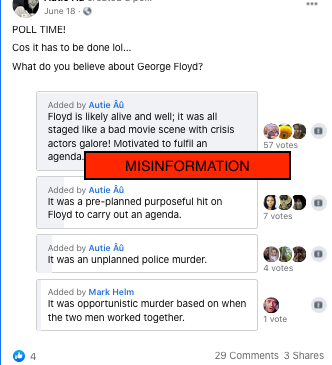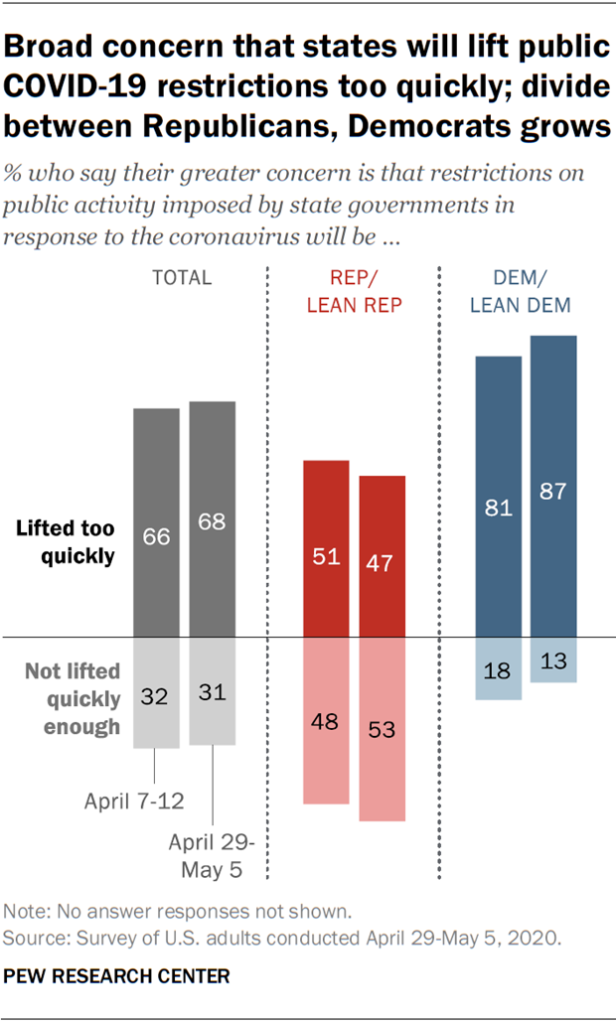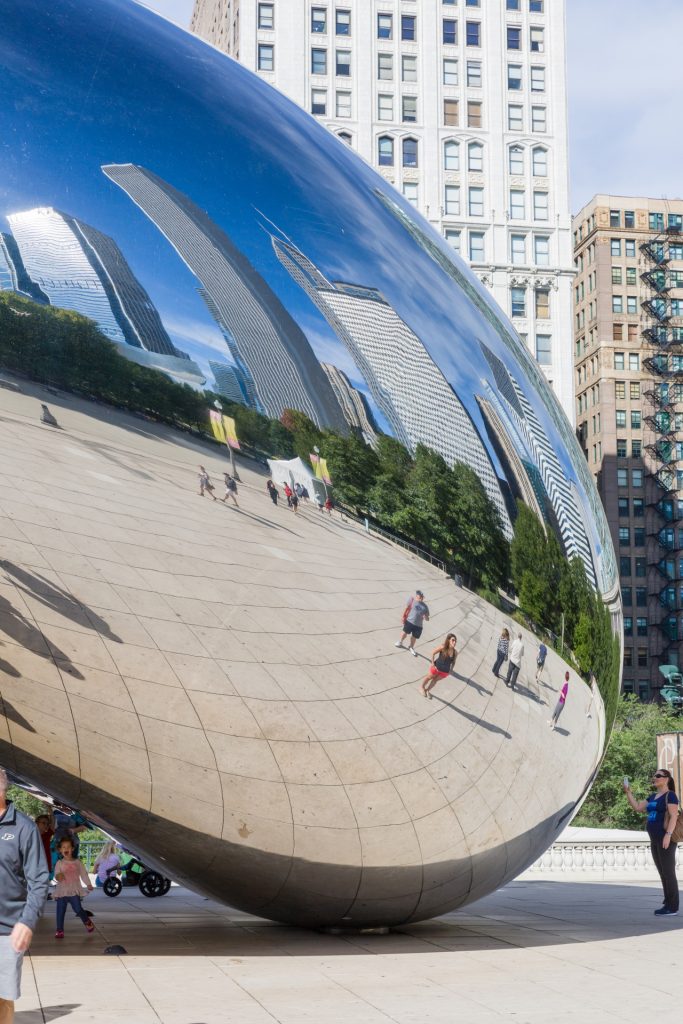The explosion of social networking and Web 2.0 sites since the early 2000s gives us an opportunity to examine how we do everything – relationships, work, social life, politics, government, and even life itself – through social media. This can tempt us to the overwhelming conclusion that the study of social media means the study of everything, everywhere. Luckily, we can always return to the basics, beginning with what social media are by definition.
What are social media, really?
Consider the terminology. The term media is the plural form of medium, which is anything through which impressions or force are transmitted to affect things on the other side. Social describes the kind of media we are talking about, because they relate to people interacting. The term social media usually refers to digital technologies that help people interact. So it’s technically correct to write “Social media are [awesome, stupid, elemental, detrimental, whatever].” But it’s also ok if you write “Social media is [changing the world, turning my friends into zombies, etc]” because the singular form is in common usage. I will use the term “social media” as both plural and singular in this book.
This is the thing about social media: it is grounded in how people talk and behave, not in rules set by any authorities. Almost any standards at work in social media can be changed by users if enough of us start pushing against those standards. We create social media. Tech developers respond to us as they create software apps, also known as software platforms. Then we tweak their apps, using them in ways that developers never planned because these unforeseen uses fit our lifestyles. Or we choose other apps that fit us better. And then those developers respond to us again.
And yes, social media does influence us too. But it can be surprising how much of what we do online was in practice in our society before social media became “a thing,” and how societal and cultural phenomena independent of technologies weave their ways into our online behaviors. Unpacking these influences requires explorations of history and theories in communication, sociology, anthropology, economics, and political science.
Case Study: What is Social Media?
Student Content
Social Media in Our Lives
On the outside, social media appears to be just another form of communication. We invest so much time in connecting with others across town, across the state, across the nation, even internationally. We post pictures that portray our daily lives whether it is the trips we go on or the people we spend time with. But social media, such as portrayed in the above story, is not always sunshine and rainbows. At least, not how it appears externally. Internally, most people have struggles and an identity that they would rather not share with the rest of the world, instead choosing to tell a happy story with no ups or downs. In a way, society has made it almost impossible for us to share the darkest parts of ourselves out of comfortability and for the portrayal of a perfect life.
My friend’s social media page has slightly altered since those years. She no longer unfollows people so her followers to following ratio is a wide range. She began to incorporate more pictures of not only her but of the accomplishments she is making and some struggles she has been having, and pictures with her friends and family. She no longer focused on the public to give her the attention and validation she so desperately craved and instead made deeper connections and reached out to her family instead. She switched her account to private while originally she had it on public in an effort to gain more attention, reminding me of the saying public by default, private by design. While her Instagram page may not completely reveal everything about her and her personal life, she no longer hides behind this utopian persona of love and laughter and has begun to understand the power social media has in the decisions made about what we want people to think about us.
When I think about my own social media page, I would like to think that I am not tricking anybody about who I am and what my life is full of. But when you think deeply about it, it is impossible for anyone to online to know everything about you, unless of course you are recording everything you do and everything you are feeling 24/7, but even though who is to say you are not acting differently because you are on camera, or lying about how you are feeling out of discomfort and wanting to appear a certain way. Is it that the affordances of social media allow us to only share so much, or is it that society has hindered our ability to share everything about ourselves?
My generation has grown up with the rise of social media. It seems as though it is part of our genetics in understanding how to use different apps or how to delete a comment we did not mean to post or even how to pretend like we did not see someone’s message when in reality we just did not feel like responding at the time it was received. We did not read any instructions on how to send a Snapchat. Instead, we clicked some buttons and figured it out on our own. It is strange to think about how social media is such an important part of our lives, but it is even stranger to think about why we let it. Why do we have these desires to post our pictures on Facebook from our weekend in Mexico? Why do we Tweet that message about how we just dropped our phone on our face while lying down? Why do we keep our Snapchat streaks with people we last talked to three years ago?
Eh, it does not need to be that deep! As long as you are using it safely and having a good time, who cares what you post!

About the author
Bella Villalpando was born and raised in the Bay Area in California. Currently she is a freshman at the University of Arizona double majoring in Care, Health & Society and Family Studies & Human Development. She is a drummer and is part of U of A’s Pride of Arizona Marching Band
Respond to this case study… This student wrote about some of the ways a user might curate their public facing identity on social media. How do the unique features of each platform inform the way users present themselves? Has social media changed the way we present ourselves and interact in the “real” world? If so, how?
Is this digital? Is this even new?
 Human behavior today can appear utterly transformed by digital technologies. When we look more closely, there are many moments today that echo behaviors of the past before digital technology played a key role. And there are many societal changes that have a variety of causes, some playing much larger roles than technology. Still, people love to claim that a technology has transformed society, perhaps because they benefit from the claim, or because it makes changing the world look easy with the proper tools. It isn’t.
Human behavior today can appear utterly transformed by digital technologies. When we look more closely, there are many moments today that echo behaviors of the past before digital technology played a key role. And there are many societal changes that have a variety of causes, some playing much larger roles than technology. Still, people love to claim that a technology has transformed society, perhaps because they benefit from the claim, or because it makes changing the world look easy with the proper tools. It isn’t.
The impacts of social media in our world are complicated. Misunderstandings around these technological platforms and practices in our world are common outcomes of flawed thinking or fallacies about this new force in our lives. In this section, we will break down some of these fallacies behind simplistic and exaggerated claims about social media in our world.
Utopian and dystopian thinking are among the most fallacies in thinking around social media. We are all familiar with utopian visions of social media – as though entering the golden gates of social media means leaving behind all the troubled communication practices that came before. A utopia is an idealized or perfect imaginary view of society. The utopian view sometimes imagines social media as a miracle disconnected from all prior human communication; other times, social media represents a more evolved social media world, where we have moved beyond all bias. The media theorist Clay Shirky conjures utopias as he describes social media’s effects on how we organize, as though they might connect everyone in the world. He is a great speaker; when I listen to him I feel comforted by the humming machines watching over us, extending our powers with God-like equanimity.
Conversely, it is also common to find social media use viewed as the downfall of society – a dystopia, or imagined society where everything is terrible. The increasing reliance of our society on social media for everyday communications looks nightmarish to some. Teens never look up from their phones. Computers make life-or-death decisions or at least remove humans from making them. Our brains are rewiring to cut out human emotions like compassion as we become robotically trained to pursue likes and connect with people we never see. Such dystopian thinking can make people jump to conclusions, and even deploy data and scientific research as hasty “proof” of their extreme conclusions, leading to moral panics or fears spread among many people about a threat to society at large.
Technological determinism is among the broadest fallacies around social media use. Technological determinism is the belief that technologies are fully responsible for grand shifts in our world, instead of acknowledging the more complicated interplay of forces behind the phenomenon in question. While social media technologies have enormous effects on our lives, human cultural and societal factors are usually also at play. The following are two claims about social media that exemplify technological determinism and explanation of their more complicated realities.
Claim: Twitter “made” the Arab Spring
Misunderstandings about the Arab Spring, an explosion of protests against governments in the Middle East in 2011. Contrary to many claims in the media, Twitter was not responsible for the Arab Spring. Twitter was an important tool there, but relationships sustained in face-to-face interaction, and old-fashioned protest in public spaces like Tahrir Square, were the foundations of the Arab Spring, as researcher Paulo Gerbaudo found and presented in his 2012 book Tweets and the Streets. Zeynep Tufecki’s research in the Middle East and in activist movements with online components has also found that while speed and ease were benefits of organizing movements online, toppling regimes as protestors in the Arab Spring accomplished required substantial offline interaction including countless cups of tea. Video footage from the Egyptian protests in media including the song lyrics and music video #Jan2 reveal intensely organized physical encounters.
Claim: Youth are addicted to social media, and this is a new phenomenon
Today’s North American teenagers choose to spend much more of their time with friends online, according to Pew Research Center, while past generations socialized more in person. However, there are many factors responsible for this other than today’s ubiquity of digital technologies. One factor is that youth are not allowed to be out as much as they once were. Today’s youth deal with parents who hover more closely and give them less freedom in public spaces than their parents were given themselves, and curfews and other restrictions remind teens that they are unwelcome in public spaces. For her 2014 book It’s Complicated, danah boyd conducted qualitative research, including interviews with teens and observations of their homes and neighborhoods. She found that teens were responding through social media use to physical restrictions on their movement, pursuing social relationships in their homes, online.
To understand the human condition in a digital era, we must critically consider claims of human transformation by and revolution through digital technologies. In other words, it is important to study what social media are actually doing in our world, as opposed to human assumptions, hopes, and fears about them.
Rely on the science you understand
Scientific research is a crucial tool for understanding any phenomenon in our world, yet the scientific methodology behind many claims around social media is misleading or poorly understood by those spreading it. Here is an example: claims that social media is ruining people’s brains are often based on interpreted neuroscience from entities like the UCLA Brain Mapping Center to support these arguments. Yet neuroscientific findings require some understanding of neuroscience and a critical approach; without these, researchers have found that neuroscientific findings can be used to add support to any claim, regardless of truth. Many turn to neuroscience when they want to add weight to their beliefs about social media, but too often that weight comes at the cost of validity and accuracy.
It is important to learn the ways these media really impact how we communicate and behave, but we can achieve considerable new understanding by using observations and conversations or interviews as human research instruments – this is the practice of qualitative inquiry or qualitative research. We can ask ourselves and those in our lives how social media shapes our world, and pursue the answers through looking, listening, and carefully interpreting. What can we learn about this new world of communication by simply sharing our stories and impressions of our behavior with social media in our lives? When we collect these accounts and analyze across them for themes – that is, when we examine social media and ourselves using qualitative inquiry – we may not feel the need for neuroscience to confirm our new knowledge.
Infinite data, limited information bridges, and rare knowledge
Even if claims around today’s technological “revolution” may be overblown, our minds and information practices are certainly changing as we use social networking sites. Among the starkest of these changes is in how we deal with ways of knowing about our world, through concepts in the discipline of Information. To understand societal changes in which social media plays a role, it is best to first understand the concepts of data, information, and knowledge. Think of data as raw material in the world of ideas and information concepts: a list of millions of likes on Instagram. A glimpse of a scene you see walking down the street but do not yet fully understand. Information is the bridge to making meaning from that data: a research article interpreting findings from a study, or a newspaper article making sense of observed phenomena such. Knowledge is what we should ideally do with information. We synthesize the information by considering it in our minds among all of our understandings of and experiences in the world, in order to truly know it as knowledge. The scene you saw on the street may be explained by the newspaper article you read. However, you may also realize from your own experience including conversations with friends around the topic that the newspaper article author presented a biased view of what you saw, or that you understand things about the scene now than the newspaper author did not.
The web allows us to take in limitless new data from many sources, and to seek out information to make sense of that data – although this will not always be good information. With so many streams of information coming in, we have trouble carefully forming knowledge, that deep sense of all we learn. Knowledge is both the most important and the most ignored stage of knowing in the digital age. In this interview for the podcast Hidden Brain, computer scientist Cal Newport describes deep work , or the act of sustained thinking and creation, as one of the few forms of human labor that computers cannot easily replace. Newport also discusses deep work in this Ted Talk.
Digital systems such as computers present us with a lot of new data points, such as pulling keywords from Twitter posts. Computers can sometimes even transform these data points into knowledge, such as by combining keywords from Twitter posts into news stories automatically emailed to you. However, to process what publics express on Twitter in the most valuable ways, posts must be studied critically – are they bots? Are they deceptive? – and carefully – what is the history behind this trend? What are the unseen forces shaping it? Journalists and analysts and many other interpreting forces online can help us make sense of this data as information, but can we trust them? Is the information true, and are their other ways of interpreting these findings that we should also seek to understand? Most importantly, what do we really know about this situation that can serve us moving forward? How can it be applied to more broadly explain phenomena in the world or predict interactions in our world?
Computers cannot create knowledge in the way it is conceptualized here, and they may never be capable of doing so. Humans can, but only if we just give ourselves time to think, study, question, and theorize. Knowledge requires processing across multiple sources of information to create new ideas.
In short, we are in an Information Age in which human knowledge is growing rarer, even as data and information proliferate. Your own knowledge must come through you. This is why in this book you will be asked to reflect on your own experiences, stories, and visions around social technologies. This will not only help you to understand how social media is impacting you; it will help shed light on a world that is often broadcast, yet little understood.
Case Study: What is Social Media?
Student Content
Social Media Can Be Dangerous
TASL: Music includes Melody 6 and Drums 4 from iVoices Innovation Pack by Gabe Stultz, iVoices Media Lab, CC-BY
Social media is certainly a recipe for disaster no matter who you ask. Many young adults invest multiple hours a day on social media, and little do they know is that although they could be having fun, social media takes a big hit on people’s mental health.
Although I have many applications on my phone, text messaging is the one that gives me the most confusion. The main issue I experience is that I tend to judge how people write back to me in their response, trying to guess how they feel. For instance, using a certain amount of laughing emojis, I tend to believe I understand if someone actually thinks something is funny. In a text message, if someone sends one laughing emoji after a particular message, the sender likely believes that the person just sent the singular emoji to make the person not feel bad. In reality, I have a gut feeling that my friend does not necessarily think it was funny, but instead just sending it, so he makes me feel better. Consequently, if numerous laughing emojis were sent back, I would conclude that he finds humor within the message. Instances like these cause me to go crazy because sometimes people don’t express their emotions as much as others do. As a result, I usually go back and forth in my mind trying to guess how my people feel.
Due to the variety of ways to communicate on the internet, there have been numerous occasions where I decided to spend my high school weekends lying in bed. Social media has caused me to become even lazier than I already was throughout high school. Staying up late, texting, and snap chatting with my best friends, I continuously felt the need to stay in the house rather than getting up and going to meet my friends for dinner or watching a sports game. I would tend to go months without actually seeing my friends because of the way social media had affected my ability to keep in touch with people, making it seem as if they were in the same room as me. However, there are many benefits to this issue. I could keep in touch with many of my good friends who lived hours away from me due to FaceTime and other ways of live video talking. At times, I felt closer to the people further away and would see those people more in person rather than the ones who lived right around the corner.
Despite all the negative implications of social media, there are some positives that have benefited me throughout my life. I have a strong passion for basketball and hope to work within the basketball media at some point in my life. I have contacted many players in their direct messages for about two years now, doing live interviews on Instagram. This social media platform has allowed me to continue networking for myself, which ultimately led to my first internship, which I received last winter. In addition, conducting interviews on Instagram allowed me to gain a larger audience, as other players would hop on the live streams to understand what I was trying to accomplish. Social media has also helped me realize what has been occurring in the sports world without watching television. Growing up, I watched SportsCenter every morning, but now all I need to do is scroll through Instagram, which will fill me in with everything I need to know. Overall, social media can be toxic, but people need to understand the benefits because the majority of our lives have benefited from modern-day technology.
About the author
Aidan Alpersdtein is from Baltimore, Maryland. At the time this was written, he was a freshman at the University of Arizona. He enjoys playing baseball and basketball. In his free time, he likes to watch the Baltimore Ravens and Orioles games. He looks forward to watching all of the U of A games while he’s in Tucson.
Respond to this case study… Has social media helped you to pursue your own passions by connecting with new communities? Has it changed the way you form or maintain friendships? Explain how (if at all) social media has affected your network(s) and how different platforms support or encourage different kinds of relating.
Core Concepts
types of flawed thinking including utopian and dystopian ideas and technological determinism
utopia
an idealized or perfect imaginary view of society
dystopia
an imagined society where everything is terrible
technological determinism
the belief that technologies are fully responsible for grand shifts in our world, instead of acknowledging the more complicated interplay of forces behind the phenomenon in question
Arab Spring
an explosion of protests against governments in the Middle East in 2011
qualitative inquiry (or qualitative research)
using observations and conversations or interviews as human research instruments
data
raw material in the world of ideas and information concepts: A list of millions of likes on Instagram, with little understanding yet applied
information
the bridge to making meaning from data, such as a research article interpreting findings from a study, or a newspaper article making sense of observed phenomena
knowledge
the outcome of synthesizing information by considering it in our minds among all of our understandings of and experiences in the world
deep work
computer scientist Cal Newport’s term for the very human act of sustained thinking and creation
Core Questions
A. Questions for qualitative thought:
- Write about a phenomenon you experience that you feel is distorted by its representation in media including social media. How do you know what you know about this phenomenon? If you can find information sources to support your understanding of it, cite or otherwise refer to them, and explain. If not, envision what information source[s] you could create based on your knowledge of the phenomenon.
- Create a concept map of data, information, and knowledge you would consider to respond to the question above.
- Consider a belief you encounter commonly that is rooted in one of the fallacies described in this chapter. Describe the belief and link to or cite an example of the flawed thinking, and identify the type of flawed thinking it is. Then, refute it.
B. Review: Which is the best answer?
Related Content
Hear It: How Facebook is undermining ‘Black Lives Matter
Listen to / read the transcript of this 27-minute episode of the podcast The Daily, “How Facebook is undermining ‘Black Lives Matter‘”. Then consider: What were your experiences around the summer 2020 Black Lives Matter protests, online and offline? Identify examples of data and information sources about them you have been exposed to, and ultimately, how your own knowledge about the protests was formed. Finally, consolidate your knowledge of the summer 2020 Black Lives Matter movement into one “finding,” or statement describing what you know about them.
Consider It: Online qualitative inquiry on the “Reopen” Protests
In April 2020, shortly after the threat of coronavirus transmission led to the shutdown of many US businesses, protests ensued. I was invited to use qualitative online research to help people understand the demands of “Reopen” protestors. Read this article and then consider these questions.
- How did I perform this online qualitative inquiry? Describe the process in your own words based on what I wrote.
- Write a summary of your knowledge today about the “Reopen” protests. Include what you learned from the article as well as other data and information sources and your knowledge and experiences. Consider especially truths you know about the world around these protests at this time that are not included in this article.
- This article is information for you, but I wrote it based on my knowledge. Draw a concept map of the data and information that go into your knowledge of the “Reopen” protests today.
What are the ‘reopen’ protesters really saying?

AP Photo/Matt Slocum
Diana Daly, University of Arizona
The “anti-lockdown” and #Reopen protests in the U.S. have powerful and secretive backers, but there are real Americans on the streets expressing their opinions.
As an ethnographer – someone who studies cultural participation – I’m interested in who those Americans are, and why they’re upset.
I spent the last week in what you might call an online road trip, studying 30 posts of protest footage from events in 15 cities. I found some shared themes, which don’t fit well with popular narratives about these protests.
1. Poverty is taboo, but work is ‘essential’
Despite the economic toll the lockdowns are taking on America’s poor, no protesters put their own poverty on display, such as posting signs asking for help.
Instead, they held signs with more general language, like “Poverty Kills,” or expressed concerns like the restaurateur in Phoenix, Arizona, who told a passing videographer he was worried about his 121 “suffering, devastated” employees.
Their messages made clear that they didn’t want to ask for a handout or charity – but they were asking to be allowed to work. Protesters across many states asserted their work – or even all work – was “essential.”
In one video from an “Operation Gridlock” protest in Lansing, Michigan, where activists planned to block traffic, a protester filmed out the window of his car when he drove past a sign saying “Give me work not money.” The protester himself called out in approval, “Give me work not money, I hear that!”
A young man at an Olympia, Washington, event described work as a source not only of money but identity: “I wanna go back to work! That pride that you feel every day when you go home from work? That’s like nothing that can … be taken.”
Protest signs in Denver, Colorado, included the plaintive “I want my career back” and the entrepreneurial “Dogs Need Groomers.”
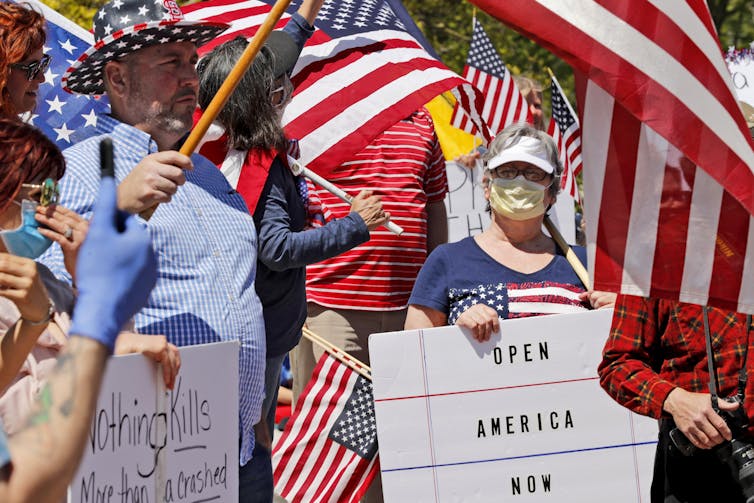
AP Photo/Jeff Roberson
2. The threat of the virus is serious
Despite alarming news reports that protesters were ignoring social distancing, many of the protesters observed safety guidelines. Photos showed at least some people wearing masks. A TikTok video recruiting participants for Michigan’s Operation Gridlock encouraged protesters to be safe; drone footage shows that most participants at the state capitol stayed in their cars, away from other people.
Protesters’ signs didn’t really downplay the threat of the virus, but rather compared it with potential harm from the lockdown. For instance, a sign in Denver was headed “Trading Lives” and featured a scale with virus deaths on one side, with unemployment, suicide and homelessness on the other.
3. Anti-science displays are on the fringe
There were protesters at several rallies who wore anti-vaccination T-shirts and held signs suggesting they don’t trust public health experts and scientists.
But only one protest was dominated by that theme. At that one, on April 18 in Austin, Texas, hundreds of attendees chanted “Fire Fauci!” referring to Dr. Anthony Fauci, director of the National Institute of Allergy and Infectious Diseases, who has been a frequent public face of the federal government’s efforts to fight the virus. That was also the rally where right-wing radio host Alex Jones, who runs a conspiracy-theory website, drove around in a truck egging on attendees’ chants through a megaphone.
At the other events, it appeared protesters had been expecting higher numbers of infections than actually happened. Rather than seeing that as evidence of the success of social distancing, they seemed to interpret this as saying the science was no longer valid. “The models were wrong” was on more than one sign, suggesting protesters had paid attention to the scientific models at first but had come to believe the disease’s seriousness had been exaggerated.
4. People want to fight the virus in familiar ways
Even when protesters acknowledged the threat of the virus, few of them were calling for medical experts to provide the solution. I saw none of the demonstrators calling for more widespread testing, for instance.
When they did express concern, protest signs coupled it with a desire to fight the contagion. In Boise, Idaho, one sign read “Freedom over Fear.” In Denver, one said “Don’t let your mask be your muzzle.”
However, the protesters wanted to fight the virus in ways that were more familiar to them and, perhaps, more empowering: In Harrisburg, Pennsylvania, a giant green truck had “Jesus is my vaccine” scrawled on its side.
Some protesters demanded governments allow people to make their own decisions, and even displayed the pro-choice slogan “My Body My Choice.” Others showed up with guns. One man in Frankfort, Kentucky, blew a shofar, a Jewish religious instrument made from a ram’s horn blown at the start of a battle.
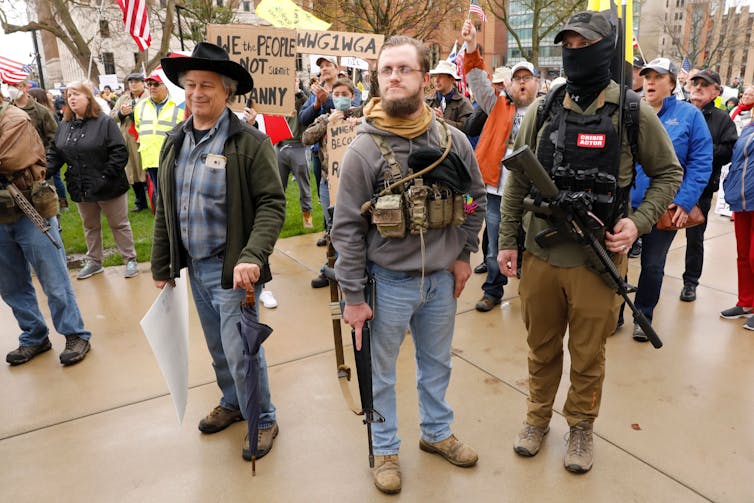
Jeff Kowalsky/AFP via Getty Images
5. ‘Tyranny’ depends on who governs, not how
In many of the events across different states, protesters objected to what they called “tyranny,” and held up the Revolution-era “Don’t Tread On Me” Gadsden flag to symbolize their resistance to government rules. They were not objecting to President Donald Trump’s April 13 declaration that, as president, his “authority is total” over the nation.
Instead they were objecting to governors’ lockdown rules, which they highlighted as overreaching their power. Many protesters likened the government’s behavior to Nazis, with protesters adding “Heil” before Democratic governors’ names.
No male governor was targeted as viciously and overtly as female Michigan Gov. Gretchen Whitmer. A widely circulated poster depicted her dressed as Adolf Hitler, giving a Nazi salute beside a swastika. Other demonstrators talked about Whitmer as though she were mothering them instead of governing them, like one who insisted, “We’re not her children!”
6. Race is a factor
One clearly visible theme in the #Reopen protests is how white the attendees are – but not just in terms of their own race. Their compassion also seemed limited to fellow white people. None that I saw were calling attention to the fact that the coronavirus doesn’t hit all populations equally: Blacks and other racial minorities had less access to high-quality health care before the outbreak, and as a result are less healthy and less able to fight off the virus when it strikes.
There was overt racism toward the Chinese, too, echoing words of the president and other political leaders, as on the Jefferson City, Missouri, sign that read “Tyranny is spreading faster than the China virus.”
7. Divided and distanced, is it a movement?
Most protesters did not refer to these protests as a movement. I found just one video offering a vision that they could form one. In that livestream from Operation Gridlock, at one point the videographer shouted, “‘merica!”
Then, his unseen companion replied in a meditative tone about the potential he saw on that road: “Together we’re strong, divided we’re weak. That’s the establishment’s biggest fear, for the people to get together and not be divided. … That’s what they fear the most. Because we have the power.” It was not clear if those people with the power included the much greater number of people across America who were sheltered in place.
[You need to understand the coronavirus pandemic, and we can help. Read The Conversation’s newsletter.]
Diana Daly, Assistant Professor of Information, University of Arizona
This article is republished from The Conversation under a Creative Commons license. Read the original article.


